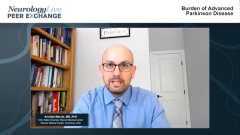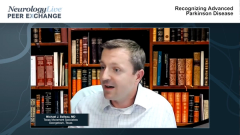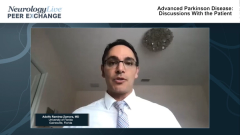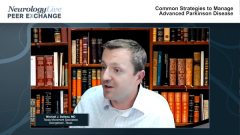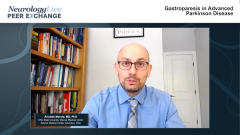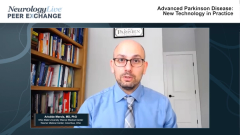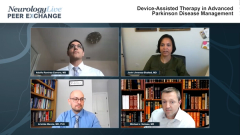
Recognizing Advanced Parkinson Disease
Michael J. Soileau, MD, discusses how to recognize when a patient has advanced Parkinson disease, what are the initial or relevant signs and symptoms of advanced disease, and how patients shift from early to intermediate and advanced disease.
Episodes in this series

Adolfo Ramirez-Zamora, MD: Michael, what do you think? When do you usually decide to start medication? Are there any instances where you may be pushing a little more? I feel that some of the instances in early Parkinson disease that make me more likely to say we need to treat this is, No. 1, if they’re having recurrent falls. Certainly, there’s always a concern about an atypical parkinsonism. But if clearly they’re having a lot of falls, then I’ll be more likely to treat them. Also if there’s danger or impairments that can affect job performance, if somebody is still working and they’re successful, they enjoy what they do, and they’re having trouble because of it, although they may not have a lot of trouble with daily activities at home. What do you think?
Michael J. Soileau, MD: Thank you for the question. I agree with what Ari said almost to a tee. I think a lot of what we do depends on the patient’s feedback. I think the pitfall that is easy to fall into is that there is an algorithm. Gone are those days, in my opinion, of an algorithm where you start with an MAO-B [monoamine oxidase-B] inhibitor, and you do a dopamine agonist, and you do this, or you do that. To me, that doesn’t work for our patients. Not to mention, we’ve learned so much more about dopamine and our treatments, and how they help symptoms or sometimes hurt symptoms.
I think it’s important to consider the patient in front of us. I would ask them just that—are these symptoms that I see on my examination, are these also symptoms you recognize on a day-to-day basis, and should we do something about them? What I find is most often patients will say, “Well, I don’t know, maybe we should hold off,” and that automatically identifies their bias. They’ve read something, there’s some piece of knowledge there that they’re holding onto, and that gives a platform for us to talk and have a discussion about what they’ve heard, what’s their understanding of Parkinson disease treatment is. Without fail, what usually happens is they say, “We certainly don’t want to start levodopa because that stops working with time, so we better wait until we absolutely need it because we don’t want to develop a tolerance to it.” That gives a great platform to educate the patient, that actually levodopa never stops working with time, but absorption changes with time, the demand always increases, and the supply certainly decreases, so we have to accommodate that and adapt to whatever level of activity they need. That’s what our brain would do naturally.
It gives a great opportunity for us to set the record straight and educate the patient, and the bottom line is if they need a treatment because it’s affecting their day-to-day [life], or they’re avoiding doing something because it’s too much effort, that’s when I would initiate treatment. Then I think the question that’s always fun to discuss is, what is that treatment, what do you start first? I think that depends on the patient’s actual symptom, more along the lines of individualizing that treatment for the patient, so there’s not just one algorithm, it depends on what that symptom is for the patient.
Adolfo Ramirez-Zamora, MD: Everything you said aligns strongly with my practice and the way I think about Parkinson disease. Joohi, any other comments about treatment? Michael briefly touched on how to recognize and start thinking about managing advanced motor symptoms, and we can transition to that discussion. But I want to give you some time to maybe briefly talk about initiation treatment, and what you think about this discussion specifically.
Joohi Jimenez-Shahed, MD: I agree with everything that’s been said. I think the theme is that it’s a very individualized approach, not individualized from the physician standpoint, but individualized from the patient standpoint. I do talk to my patients, even in early cases where maybe symptoms are mild and they’re not impairing, to potentially think about using some of the milder medications for Parkinson disease, like rasagiline, for example. This drug has few [adverse] effects, especially when it’s used in monotherapy, and while not proven in a clinical trial standpoint, it certainly has a potential for slowing cell death. So, if there’s any drug that we might be able to use for that, this is the conversation I have with patients, that perhaps they want to consider using it as a mild treatment. I think patients do better if we treat them earlier, and while there is room for conversation, discussion, and making the right decision for that individual patient, I try to encourage at least a mild medicine like that at the beginning.
If patients are experiencing disability, I agree with you, exactly what you said, Adolfo. If they have gait issues, balance issues, risk of fall or other consequences of not managing their symptoms, then I often have that conversation that Michael was talking about, which is maybe you should try it, let’s see what happens, and I kind of make a deal with them. If we try the medication and they feel better, then great, we can stay on it, we’ll be happy we did it. If we try the medicine and they don’t feel better, then we can always back off and go back to square one. Usually that’s a conversation that’s successful in at least helping to demonstrate to patients the benefit they can have from these medications. More often than not, that’s the way the conversation goes.
But I think it is tricky, and when I see my patients, especially in those advanced stages or in stages where they are experiencing those complications of fluctuations and the dyskinesias, I’ll run through my list of the questions: what’s your ON time; what’s your OFF time; how are these medications working for you? The next question I’ll ask, for example somebody might say, “Oh, I’m doing fine, the medications are kicking in, they’re lasting the whole time, etc.” But then I ask them, “What are you doing during your day, what are you trying to accomplish?” Then we dig deeper into that day-to-day functioning, and sometimes we’ll find things that we realize, you know what, that might actually be an opportunity to improve the situation if we make an adjustment in medication. It does have this mixture of motor functioning as well as quality of life and day-to-day activities. It’s not the recipe; there isn’t a single recipe.
Adolfo Ramirez-Zamora, MD: Thank you all for watching this NeurologyLive® Peer Exchange, and if you enjoyed the content, please subscribe to our e-newsletter to receive upcoming Peer Exchanges and other great content right in your inbox. Thank you so much.
Transcript Edited for Clarity
Newsletter
Keep your finger on the pulse of neurology—subscribe to NeurologyLive for expert interviews, new data, and breakthrough treatment updates.

